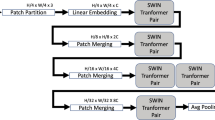Abstract
This paper introduces an autonomous hybrid technique designed for the digital restoration of the missing parts and occluding artifacts in damaged historical or artistic color documents. For this purpose, a hyperspectral imaging device is used to acquire sets of images in the visible and near infrared ranges. Assuming the presence of linearly mixed pixels registered from the spectral images, our technique uses two lattice auto-associative memories to extract the set of pure pigments spectra. Fractional abundance maps indicating the distributions of each pigment along the image are obtained by spectral linear unmixing. These maps are then used to locate holes and cracks in the document under study. The restoration process is performed by the application of a modified morphological region filling algorithm, followed by a vectorial linear interpolation scheme to restore the original color appearance of the filled areas. For illustration purposes, our procedure has been applied successfully to the restoration of superimposed scripts and an art painting.




Similar content being viewed by others
Notes
Although the abundance map for the white paper is not shown, it was also estimated by including its corresponding spectral signature as another column of S.
References
Fisher, C., Kakoulli, I.: Multispectral and hyperspectral imaging technologies in conservation: current research and potential applications. Rev. Conserv. 7, 3–16 (2006)
Barni, M., Bartolini, F., Cappellini, V.: Image processing for virtual restoration of artworks. IEEE Multimed. Mag. 7(2), 34–37 (2000)
Baronti, S., Casini, A., Lotti, F., Porcinai, S.: Multispectral imaging system for the mapping of pigments in works of art by use of principal component analysis. Appl. Opt. 37, 1299–1309 (1998)
Ware, G.A., Chabries, D.M., Christiansen, R.W., Brady, J.E., Martin, C.E.: Multispectral analysis of ancient Maya pigments: implications for the Naj Tunich Corpus. In: Proceeding of IEEE: IGARSS, Honolulu, HI, 24–28 July, pp. 2489–2491 (2000)
Easton, R. L., Knox, K. T., Christens-Barry, W. A.: Multispectral imaging of the Archimedes palimpsest. In: Proceeding of IEEE: 32nd Applied Imagery Pattern Recognition Workshop, pp. 111–116 (2003)
Rapantzikos, K., Balas, C.: Hyperspectral imaging: potential in non-destructive analysis of palimpsest. In: Proceeding of IEEE: ICIP, 11–14 Sept, vol. 2, pp. 618–621 (2005)
Liang, H.: Advances in multispectral and hyperspectral imaging for archaeology and art conservation. Appl. Phys. A, 106, 309–323 (2012)
Tonazzini, A., Savino, P., Salerno, E.: A non-stationary density model to separate overlapped texts in degraded documents. SIViP 9(1), 155–164 (2015)
Kim, S.J., Deng, F., Brown, M.S.: Visual enhancement of old documents with hyperspectral imaging. Pattern Recognit. 44, 1461–1459 (2011)
Hedjam, R., Cheriet, M.: Historical document image restoration using multispectral imaging system. Pattern Recognit. 46, 2297–2312 (2013)
Gonzalez, R.C., Woods, R.E.: Digital Image Processing, 3rd edn. Pearson Prentice Hall, New Jersey (2008). (Ch. 9)
Spagnolo, G.S., Somma, F.: Virtual restoration of cracks in digitized image of paintings. J. Phys. Conf. Ser. 249(1), 012059 (2010)
Barni, M., Pelagotti, A., Piva, A.: Image processing for the analysis and conservation of paintings: opportunities and challenges. IEEE Signal Process. Mag. 22(5), 141–144 (2005)
Ritter, G.X., Sussner, P., Díaz de León, J.L.: Morphological associative memories. IEEE Trans. Neural Netw. 9(2), 281–293 (1998)
Graña, M., Chyzhyk, D.: Image understanding applications of lattice autoassociative memories. IEEE Trans. Neural Netw. Learn. Syst. 27(9), 1920–1932 (2016)
Ritter, G.X., Gader, P.: Fixed point of lattice transforms and lattice associative memories. In: Hawkes, P. (ed.) Advances in Imaging and Electron Physics, vol. 144, pp. 165–242. Elsevier, Amsterdam (2006)
Birkhoff, G.: Lattice Theory, 3rd edn. American Mathematical Society, Providence, RI (1967)
Kaburlasos, V.G., Ritter, G.X. (eds.): Computational Intelligence Based on Lattice Theory. Springer, Berlin (2007)
Keshava, N., Mustard, J.F.: Spectral unmixing. IEEE Signal Process. Mag. 19(1), 44–57 (2002)
Lechuga-S, E., Valdiviezo-N, J.C., Urcid, G.: Multispectral image restoration of historical documents based on LAAMs and mathematical morphology. In: Proceeding of SPIE: Optics and Photonics for Information Processing VIII, San Diego, CA, 17 Aug 2014, p. 921604 (2014)
Urcid, G., Ritter, G.X.: \(C\)-means clustering of lattice auto-associative memories for endmember approximation. In: Advances in Knowledge-Based and Intelligent Information Systems, vol. 243, pp. 2140–2149. IOS Press, Amsterdam (2012)
Valdiviezo-N, J.C., Urcid, G.: Lattice algebra approach to multispectral analysis of ancient documents. Appl. Opt. 52(4), 674–682 (2013)
Haralick, R.M., Sternberg, S.R., Zhuang, X.: Image analysis using mathematical morphology. IEEE Trans. Pattern Anal. Mach. Intell. 9(4), 532–550 (1987)
Vincent, L.: Morphological grayscale reconstruction in image analysis: applications and efficient algorithms. IEEE Trans. Image Process. 2(2), 176–201 (1993)
Soille, P.: Morphological Image Analysis: Principles and Applications, 2nd edn. Springer, Berlin (2003)
Ng, T., Lee, V., Gallagher, R., Coldman, A., McLean, D.: Dullrazor\(\textregistered \): a software approach to hair removal from images. Comput. Biol. Med. 27(6), 533–543 (1997)
H.P.: Headwall Photonics. http://headwallphotonics.com
Jacobson, N.P., Gupta, M.R.: Design goals and solutions for display of hyperspectral images. IEEE Trans. Geosci. Remote Sens. 43(11), 2684–2692 (2005)
Hedjam, R., Cheriet, M.: Ground-truth estimation in multispectral representation space: application to degraded document image binarization. In: Proceeding of IEEE: International Conference on Document Analysis and Recognition, Washington, DC, 25–28 Aug 2013, pp. 190–194 (2013)
L.M.C.T.: Synchromedia: laboratory for multimedia communication in telepresence. http://synchromedia.ca/databases/msi-histodoc?page=1
Acknowledgements
Edwin Lechuga thanks the National Council of Science and Technology (CONACyT) for scholarship No. 556848. Juan C. Valdiviezo and Gonzalo Urcid are grateful with the National Research System (SNI-CONACyT) in Mexico city for partial support through Grant Nos. 57564 and 22036, respectively.
Author information
Authors and Affiliations
Corresponding author
Rights and permissions
About this article
Cite this article
Valdiviezo-N, J.C., Urcid, G. & Lechuga, E. Digital restoration of damaged color documents based on hyperspectral imaging and lattice associative memories. SIViP 11, 937–944 (2017). https://doi.org/10.1007/s11760-016-1042-y
Received:
Revised:
Accepted:
Published:
Issue Date:
DOI: https://doi.org/10.1007/s11760-016-1042-y




